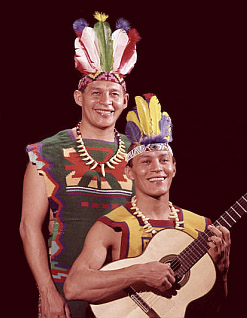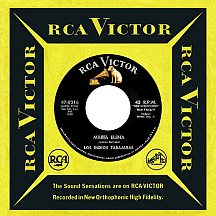LOS INDIOS TABAJARAS
Maria Elena
The indigenous tribes of Northeastern Brazil had been around hundreds, perhaps thousands, of years without most of the world knowing of their existence. Only the European explorers and merchants of about five centuries ago, particularly the Portuguese, had become familiar with the many such tribes in this expansive region of South America, sometimes trading with them, occasionally living among them and more outrageously battling them in a struggle against the French (whom the locals had sided with) to take over Brazil, which Portugal eventually conquered. One such tribe, the Taba-Jara, lived near Tianguá in an isolated part of the state of Ceará several centuries later and it was from this relatively small group of primitive, Tupi-speaking natives that an improbable, extraordinary thing happened: two young brothers stumbled across a random object and as a result became popular music stars under a name that gained their tribe worldwide recognition: Los Indios Tabajaras.
The brothers, born within a year of one another, were given the simple names Mussapere and Herundy; their father, Mitanga, was one of the tribe's leaders. Sometime during the 1930s, the adolescent siblings discovered a guitar that had been left by someone who'd passed through the area. They managed to get it back to the village without coming too close to it, after which it sat for weeks until they decided it wouldn't explode like other objects (usually left by the military) had done. Later, the guitar became fascinating, they loved the sounds made when it was strummed and very slowly taught themselves how to play it in a rudimentary way. In 1936 a military expedition arrived, led by Lieutenant Moreira Lima who, with accompanying missionaries, sought to introduce Christianity to the primitive people. Noting the brothers' crude but impressive guitar abilities, he took them to Rio de Janeiro, some 2600 miles due south, to study music under a proper turorship. He also changed their names to his: Natalicio Moreira Lima ("Nato") and Antenor Moreira Lima ("Tenor").
By the early 1940s they had an agent who booked concert appearances throughout the Rio area and were soon signed to RCA Victor's Latin American label. For several years, Nato and Tenor regularly performed across South America, their repertoire including both vocal (Italian, Greek, German and their native Tupi) and popular instrumental selections, while the pair strove to improve their musical expertise. Around 1950 they stopped touring in favor of studying with higher-level instructors in an effort to fully understand music theory and the art of dual-guitar craft. Nato focused on melody, while Tenor perfected harmony accompaniment (lead and rhythm guitar as some would call it, but at a classical level). Once touring resumed, they began appearing in ceremonial Indian garb, colorful outfits with headdresses intended less as a gimmick than a tribute.

The 1957 album Popular and Folk Songs of Latin America, covering a variety of traditional pieces from various countries, was recorded in Mexico in 1957 and released in the U.S. on the VOX label. The following year, Sweet and Savage, the first LP with a cover photo of the brothers wearing the Indian outfits, became their full-fledged U.S. debut on RCA Victor and first in "Living Stereo." "Maria Elena," a Mexican standard by that time, had been written in 1932 by Veracruz-born composer Lorenzo Barcelata. The instrumental was featured on the soundtrack of director Archie Mayo's 1935 film Bordertown starring Paul Muni and Bette Davis; a Spanish vocal version was heard in the 1936 Mexican film Maria Elena and its U.S. re-release She-Devil Island. The song, with English lyrics by Bob Russell (credited as S.K. Russell), had been a number one hit in 1941 for The Jimmy Dorsey Orchestra featuring vocalist Bob Eberley. A peaceful, lovely instrumental rendition of the song led off side one of the '58 Los Indios album, but sales were disappointing and there was no single.
Finally, in 1963, the song was given a 45 release and surprisingly reached the top ten, not just in America but in several other countries around the globe. The Maria Elena album (a retitled reissue of Sweet and Savage) was also a top ten seller. In early '64 the brothers had another charting single, "Always in My Heart," a fine remake of a standard by the great Latin composer Ernesto Lecuona. Albums came afterwards at a steady clip; by the end of the decade there were 15 (sometimes with the phrase "Twin Guitars" on covers) including a 1966 stint providing the sonic backing on Don Gibson with Spanish Guitars (which includes Don's vocal version of "Maria Elena").
Nashville's guitar master Chet Atkins was a big Los Indios fan and the brothers returned the sentiment with a gift: a Del Vecchio Dinâmico resonator guitar from their native country, which Chet played on his 1964 album My Favorite Guitars. Singles by the duo were issued occasionally through 1967, some of them remakes of hits like Anton Karas's "Third Man Theme" and the mid-'40s Les Brown/Doris Day smash "Sentimental Journey," but no further hits emerged. Concert appearances, on the other hand, became a constant routine as they crisscrossed North America performing for S.R.O. crowds. Who cares about a hit single when you're playing to deafening applause at Carnegie Hall?
While touring in Tokyo, Natalicio met Michiko Mikami, who had studied classical piano for several years. She moved from Japan to New York City and they were married in 1971. The brothers had done away with the Indian costumes years before; by 1979, Antenor grew weary of recording and touring and decided to retire. Nato, on the other hand, had no desire to quit. Michiko had never played guitar but offered to take Tenor's place. For well over a year her husband taught her everything he knew while they practiced constantly and insisted on seeing no one. Even Nato's manager had a hard time getting in touch. In 1980, the act resumed, using the original name. An odd couple? - a former Brazilian tribesman and Japanese pianist/wife playing guitars together professionally. No, a happy couple! - they kept it going for two more decades.
The story of Los Indios Tabajaras is quite unlike any other. The Gods Must Be Crazy, a wacky 1980 South African film that starts with a similar premise, seems as if it was inspired by the Lima brothers, though their found item had more inherent value than a mere Coke bottle and an outcome far more spectacular: two youngsters found a guitar in their 1930s forest home and spent most of the remaining century recording, traveling the world and performing for millions.


